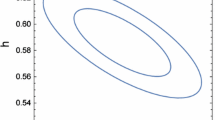Abstract
We study some cosmological models endowed with a peculiar scalar field known as stealth field. The models are constructed by considering a scalar field \(\phi \) obeying a non-minimal coupling to the gravitational field where the matter content is provided by both dust and a perfect fluid. Moreover, we analyze the stealth field implications in the cosmology by assuming a power-law behavior for the scale factor. Surprisingly, we find that stealth configurations that emerge, which in principle have no back-reaction to the background space-time, do contribute to the cosmological dynamics. We provide analytical expressions of these contributions to the energy density coming from the matter sources considered as well as for the pressure in the power-law scenario. This is a first signal that the stealth fields contributions are quantifiable. In the de Sitter cosmology, we found stealth does not have contributions either to cosmological constant or deceleration parameter. Additionally, we discuss the behaviors of the self-interaction potential for some particular values of the parameters involved.





Similar content being viewed by others
References
Alvarez, A., Campuzano, C., Cruz, M., Rojas, E., Saavedra, J.: Gen. Relativ. Gravit. 48(12), 165 (2016). https://doi.org/10.1007/s10714-016-2158-7
Astashenok, A.V., Odintsov, S.D.: Phys. Lett. B 718, 1194 (2013). https://doi.org/10.1016/j.physletb.2012.12.058
Ayón-Beato, E., Martínez, C., Troncoso, R., Zanelli, J.: Phys. Rev. D 71, 104037 (2005). https://doi.org/10.1103/PhysRevD.71.104037
Ayón-Beato, E., Martínez, R., Zanelli, J.: Gen. Relativ. Gravit. 38(1), 145 (2006). https://doi.org/10.1007/s10714-005-0213-x
Ayón-Beato, E., García, A.A., Ramírez-Baca, P.I., Terrero-Escalante, C.A.: Phys. Rev. D 88(6), 063523 (2013). https://doi.org/10.1103/PhysRevD.88.063523
Ayón-Beato, E., Hassaïne, M., Juárez-Aubry, M.M.: Preprint (2015). 1506.03545 [gr-qc]
Ayón-Beato, A.A., Ramírez-Baca, P.I., Terrero-Escalante, C.A.: Phys. Rev. D 97(4), 043505 (2018). https://doi.org/10.1103/PhysRevD.97.043505
Babichev, E., Charmousis, C.: J. High Energy Phys. 1408, 106 (2014). https://doi.org/10.1007/JHEP08(2014)106
Babichev, E., Charmousis, C., Hassaïne, M.: J. Cosmol. Astropart. Phys. 1505, 031 (2015). https://doi.org/10.1088/1475-7516/2015/05/031
Banerjee, N., Jain, R.K., Jatkar, D.P.: Gen. Relativ. Gravit. 40, 93 (2008). https://doi.org/10.1088/1475-7516/2015/05/031
Bento, M.C., Bertolami, O., Sen, A.A.: Phys. Rev. D 66, 043507 (2002). https://doi.org/10.1103/PhysRevD.66.043507
Bravo Gaete, M., Hassaïne, M.: J. High Energy Phys. 1311, 177 (2013a). https://doi.org/10.1007/JHEP11(2013)177
Bravo Gaete, M., Hassaïne, M.: Phys. Rev. D 88, 104011 (2013b). https://doi.org/10.1103/PhysRevD.88.104011
Bravo-Gaete, M., Hassaïne, M.: Phys. Rev. D 90(2), 024008 (2014). https://doi.org/10.1103/PhysRevD.90.024008
Callan, C.G. Jr. Coleman, S.R., Jackiw, R.: Ann. Phys. 59, 42 (1970). https://doi.org/10.1016/0003-4916(70)90394-5
Campuzano, C., Cárdenas, V.H., Herrera, R.: Eur. Phys. J. C 76(12), 698 (2016). https://doi.org/10.1140/epjc/s10052-016-4546-2
Charmousis, C., Copeland, E.J., Padilla, A., San, P.M.: Phys. Rev. Lett. 108, 051101 (2012). https://doi.org/10.1103/PhysRevLett.108.051101
Cisterna, A., Hassaïne, M., Oliva, J., Rinaldi, M.: Phys. Rev. D 90(10), 104039 (2016). https://doi.org/10.1103/PhysRevD.94.104039
Cordero, R., Vilenkin, A.: Phys. Rev. D 65, 083519 (2002). https://doi.org/10.1103/PhysRevD.65.083519
de Haro, S., Papadimitriou, I., Petkou, A.C.: Phys. Rev. Lett. 98, 231601 (2007)
Faraoni, V., Zambrano-Moreno, A.F.: Phys. Rev. D 81, 124050 (2010). https://doi.org/10.1103/PhysRevD.81.124050
Frieman, J.A., Hill, C.T., Stebbins, A., Waga, I.: Phys. Rev. Lett. 75, 207 (1995). https://doi.org/10.1103/PhysRevLett.75.2077
Hassaïne, M.: Phys. Rev. D 89(4), 044009 (2014). https://doi.org/10.1103/PhysRevD.89.044009
Kamenshchik, A.Yu., Moschella, U., Pasquier, V.: Phys. Lett. B 511, 265 (2001). https://doi.org/10.1016/S0370-2693(01)00571-8
Maeda, H., Maeda, K.I.: Phys. Rev. D 86, 124045 (2012). https://doi.org/10.1103/PhysRevD.86.124045
Perlmutter, S., et al.: Astrophys. J. 517, 565 (1999). https://doi.org/10.1086/307221
Quinzacara, C., Meza, P., Sampson, A., Valenzuela, M.: Eur. Phys. J. C 78(11), 950 (2018). https://doi.org/10.1140/epjc/s10052-018-6441-5
Quinzacara, C., Meza, P., Sampson, A., Valenzuela, M.: Preprint (2019). 1904.00494 [hep-th]
Ratra, B., Peebles, P.J.E.: Phys. Rev. D 37, 3406 (1988). https://doi.org/10.1103/PhysRevD.37.3406
Ries, A.G., et al.: Astron. J. 116, 1009 (1998). https://doi.org/10.1086/300499
Sahni, V., Wang, L.-M.: Phys. Rev. D 62, 103517 (2000). https://doi.org/10.1103/PhysRevD.62.103517
Scherrer, R.J.: Phys. Rev. Lett. 93, 011301 (2004). https://doi.org/10.1103/PhysRevLett.93.011301
Schmidt, B.P.: Astrophys. J. 507, 46 (1998). https://doi.org/10.1086/306308
Smolić, I.: Phys. Rev. D 97(8), 084041 (2018). https://doi.org/10.1103/PhysRevD.97.084041
Sokolowski, L.M.: Acta Phys. Pol. B 35, 587 (2004)
Steinhardt, P.J., Wang, L.-M., Zlatev, I.: Phys. Rev. D 59, 123504 (1999). https://doi.org/10.1103/PhysRevD.59.123504
Turner, M.S., White, M.J.: Phys. Rev. D 56(8), 4439 (1997). https://doi.org/10.1103/PhysRevD.56.R4439
Wetterich, C.: Nucl. Phys. B 302, 668 (1988). https://doi.org/10.1016/0550-3213(88)90193-9
Acknowledgements
Authors thank to Eloy Ayón-Beato for enlightening discussions. Special thanks to Carlos Manuel Rodríguez. CC acknowledges partial support by CONACyT Grant CB-2012-177519-F and grant PROMEP, CA-UV, Álgebra, Geometría y Gravitación. This work was partially supported by SNI (México). VHC acknowledges partial support by DIUV-REG-50/2013. AA acknowledges partial support by CONACyT Grant Estancias Posdoctorales Vinculadas al Fortalecimiento de Calidad del Posgrado Nacional 2017.
Author information
Authors and Affiliations
Additional information
Publisher’s Note
Springer Nature remains neutral with regard to jurisdictional claims in published maps and institutional affiliations.
Appendix: Stealth field equation
Appendix: Stealth field equation
We study the consequences of the stealth in cosmology, Einstein’s field equations for a perfect fluid source are furnished by
here \(G_{\mu \nu }\) is are the Einstein tensor, \(T^{m}_{\mu \nu }\) is the energy momentum tensor of a perfect fluid
where \(p=p(t)\) is the pressure, \(\rho =\rho (t)\) the energy density, \(u_{\mu }\) is the fluid velocity four vector with \(u_{\mu }u^{\mu }=1\). \(T^{s}_{\mu \nu }\) is the stress energy tensor of the stealth field (3).
The Friedmann-Lemaitre-Robertson-Walker metric for a homogeneous isotropic universe is provided by
where \(k=\pm 1,0\), indicating the spatial curvature constants. In the case \(k=0\) the field equations for the background are given by
and the continuity equation that satisfies the fluid is
Now, we assume that the universe is spatially flat and the dust case, i.e. when the pressure is zero. We go back to Eqs. (66) and (68), to obtain that density and scale factor are given explicitly in the form
in thats case the equations for the stealth are given by Eq. (13).
Expanding Eq. (13), explicitly we get
now, in order to get an analytical solution of the stealth field, we propose \(\phi =\phi (a(t))=\phi (a)\) in Eq. (13). Now, the field equation is given by
From (70) is easy to shown
then Eq. (72) finally have the form
factorizing \(\frac{1}{\phi }\frac{d\phi }{da}=\frac{d \ln \phi }{da}\) and rearranging terms and by substituting the expressions of \(\dot{a}^{2}\) and \(a_{1}^{2}\) one arrive at Eq. (14).



